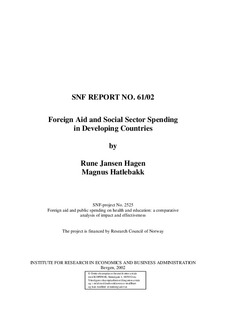| dc.contributor.author | Hagen, Rune Jansen | |
| dc.contributor.author | Hatlebakk, Magnus | |
| dc.date.accessioned | 2006-06-26T10:03:42Z | |
| dc.date.available | 2006-06-26T10:03:42Z | |
| dc.date.issued | 2002 | |
| dc.identifier.isbn | 82-491-0253-3 (trykt versjon) | |
| dc.identifier.issn | 0803-4036 | |
| dc.identifier.uri | http://hdl.handle.net/11250/165245 | |
| dc.description.abstract | Foreign aid is of critical importance to achieving the international goal of providing basic social services to all mankind by 2015. If strategies for funding health and education are to be successful, understanding the link between aid and spending priorities in recipient countries is vital. Transfers might only have an income effect, and thus no impact on relative sectoral spending. We test this hypothesis of no influence by comparing the marginal effects of domestic public revenues and aid on public spending within the social sectors using data from a panel of recipient countries. We conclude that no influence is not the general pattern. In the aggregate, this is not due to success in targeting these sectors. Moreover, transfers from the large bilateral donors tend to reduce the priority given to social spending. However, the "soft" bilateral donors - those devoting more than 0.7% of their GNI to aid - succeeds in raising the budget share of the social sectors by using ear-marked aid. Our conjecture is that this is due to a combination of generous funding and differences relative to recipients in the prioritisation of specific projects in these sectors showing up in the aggregate data. | en |
| dc.format.extent | 160030 bytes | |
| dc.format.mimetype | application/pdf | |
| dc.language.iso | eng | en |
| dc.publisher | SNF | en |
| dc.relation.ispartofseries | Report | en |
| dc.relation.ispartofseries | 2002:61 | en |
| dc.title | Foreign aid and social sector spending in developing countries | en |
| dc.type | Research report | en |
